
Wednesday 30th October From Spain to Portugal – Duero to Douro! 83 miles
There really was a frost this morning! Mist filled the valley, but there was a blue sky. The day started cold, but warmed up in the afternoon and we both put on our shorts!
We received an email from Rosemarie saying that it had been very windy at home.
We left at 9.30 and descended to the (dammed) River Duero. We met a very long lorry on a hairpin bend, so had to reverse. We drove across the dam, which was full of hydroelectric stuff, so wasn’t very pretty! We drove across wild moorland with stone walls to the River Duero again, after its long meander. It now formed the border between Spain and Portugal. We could see the town of Miranda do Douro above the river. We stopped by the 80 metre high dam, where the water was absolutely still. The reflections looked beautiful. It was so peaceful.
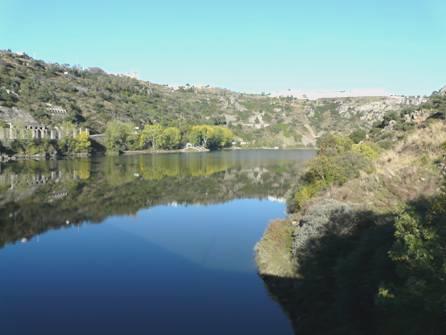
The peaceful River Duero at Miranda
We drove on round to Miranda, looking down to the dramatic gorge. Boat trips go from here, and we saw a boat leaving. We stopped to have our coffee on a stone wall above the gorge.


Above the Douro Gorge at Miranda, Portugal
We were finally able to get an internet connection in the town, and see the photos which Tom had sent of Rita with her new baby cousin, and from Simon with a photo of him finishing his half marathon.
We drove on to the old town and walked around. It was very different from old towns in Spain. The stone houses here were all painted white. The streets here were cobbled too, with a paved section down the centre.
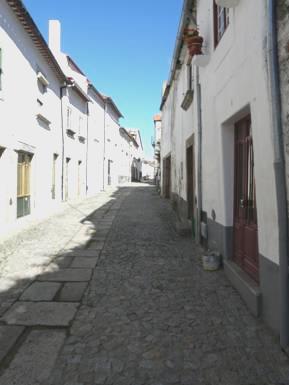
Miranda
There were remains of an ancient castle and an enormous stark church, which used to be a cathedral, with remains of more antiquity beside it. There were lots of little shops, but we didn’t find a bakers. We went into a tiny supermarket, where the elderly gent produced three loaves to choose from. We didn’t know which language to speak, as the people here apparently still speak Mirandes, a language of this area, dating from the time when all these remote villages were isolated from the rest of the world. It’s a mixture of French, Spanish and Portuguese Street names were ‘Rue de la‘! Miranda apparently has a type of stick dancing rather like Morris dancing, which would have been fun to see.
We conversed with our man with smiles, and he just repeated what he’d said. We returned to the van, and ate our lunch sitting on a stone block above the gorge, just annoyed by flies and wasps.
Adrian looked at the sat nav, and realised that Portuguese time is one hour behind Spain, so the same as England. If we knew it before, we’d forgotten. Hence we set off at 1 o’clock, not 2 o’clock to drive on a small road near the Douro. We came to a little village, Freixosa, which was out of this world! The little houses were crumbling, with the red tiled roofs. There was even a donkey, and an old well. An old lady was sitting knitting in a doorway, and the men wore flat cap, check shirt and dungarees. The road descended steeply to the river – we just walked around a bit. As we drove off, a local stopped us, and said jokingly ‘passport’. He then smiled, and tried to converse with us. He asked if we were on holiday, and said something like ’bon voyage’ and tried to tell us somewhere to eat. It was a happy encounter.
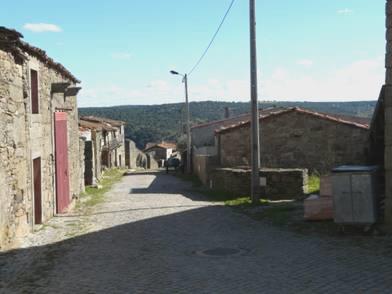

Freixosa
We can remember seeing peasant people on our 1996 trip to Portugal. We were surprised to still see peasants dressed in black now – an old lady carrying sticks. Time seems to have stood still in parts of this area.
As we drove on, we passed a ‘shadoof’ contraption at the edge of a field. The stone walls were made of single vertical rocks.
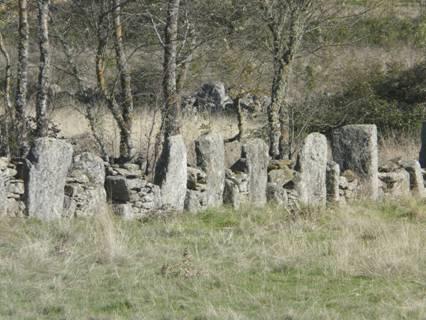
A stone fence
We turned off to another dam/reservoir and looked down to the dramatic gorge. As we drove on, there was a parallel new road beside us, with no traffic on either, like in Spain.
We now followed the sat nav on a road not on our map. We were driving through agricultural country, and later more hilly, forested country, and then fields with huge boulders strewn in them. When we pulled in to have a cup of tea, Adrian found some chestnuts lying on the ground.
We turned off to a viewpoint with amazing views down to the River Douro far below. We could see the green hills of Spain on the other side, and just one or two small villages. Voices carried from way beneath us. It was really peaceful.
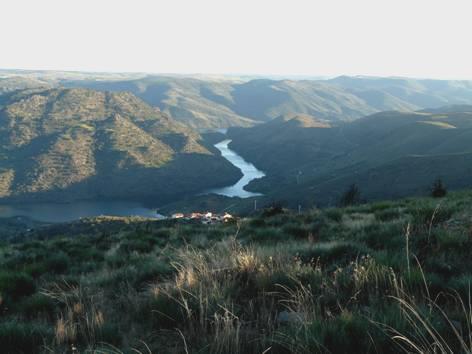
Another lovely view of the Douro
There was nowhere wide enough for us to pull in for the night, so we continued to an Aire at Freixo de Espada a Cinta.
Thursday 31st October Olives, vines and prehistory 62 miles
The night was cold again, but quiet except for the noise of dogs barking. The sky was blue. We left at 9.20 (Portuguese time), after dumping and getting water. We found no supermarket or internet in the town so set off through the terraced hills of olives and vines back to the Douro River. We pulled in above yet another dammed section (Embalse de Saucelle) enjoying the dramatic view of the forested hills and the sun on the water. We followed along high above the Douro, taking in the view. We stopped to have our morning break sitting on a stone wall at a ‘picnic site’, with an opuntia cactus beside us. We enjoyed the peace (until dogs barked from the only house around).
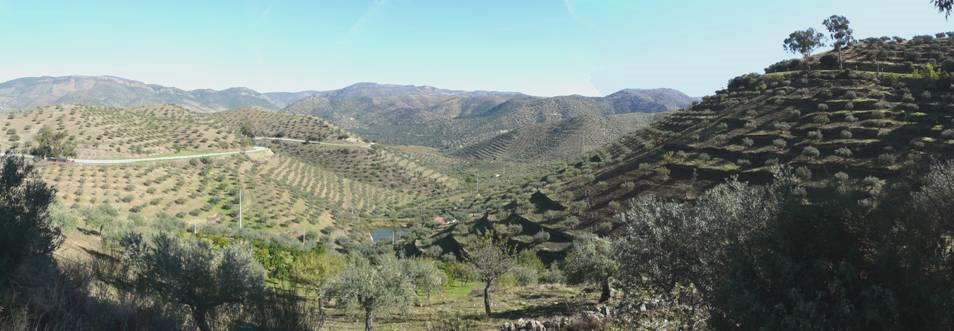
Olive trees making lovely patterns
We crossed the Douro at Barca de Alva – the border with Spain follows the River Aquedo now. We spied a tiny supermarket with a bright bougainvillea outside. It looked closed, but was in fact open. Inside was a very old fashioned shop with a conglomeration of goods, and with a mess of material and tablecloths occupying one end of it.
We wanted at least to buy a loaf of bread, but couldn’t see any. The elderly lady assistant was in conversation with an irate sounding peasant woman, dressed in black. The customer never stopped talking for a second. Finally I broke in and asked if they had bread. ‘No’ was the answer – still the old lady didn’t stop talking!
Our road now wound up, away from the river. There were spectacular views of the olive trees making wonderful patterns on the hill sides. We stopped at Miradour Alto da Sapinha where it was so peaceful with just the sound of birdsong as we looked down.
We drove through another village, where there were a few bars, but no bakers! We then drove across uncultivated moorland until we came to the town of Figueira. We drove right around it, passing all sorts of shops except food shops, until finally we found a supermarket. The girl assistant smiled as she said ‘thank you’ in English. People do always seem pleased if they can use their bit of English. On driving out of the town, we passed another supermarket – Intermarche – and as we hadn’t bought any fish in the first one, went in to get some. At the checkout this time, we shared a joke with the cashier, but we don’t know what about!
High on a hill we could see the remains of a castle, Castello Rodgrigo, so headed there. We stopped to have our lunch sitting outside at a pleasant but neglected picnic area below the town. It was warm and peaceful as we looked up to the castle and village, we were just annoyed by the flies and the occasional bark from a dog!

Castello Rodrigo
Afterwards we drove up and walked around the walled town with its castle ruins. The narrow streets were of rough cobbles, with a paved section down the centre. It was absolutely peaceful – the only people about were the workers restoring one of the houses. Some of the restoration work didn’t seem to be in keeping. The views down all around were wonderful.
We now drove back to the River Douro, coming first to the River Coa, which joins the Douro. We pulled in just before a fine road bridge, and were amused that the car parking spaces weren’t even long enough for a bicycle!
We drove on into Vila Nova de Foz Coa looking for the tourist information. This area is renowned for its prehistoric rock art, which was first discovered in the nineties. The smart town looked quite different from others with its palm trees lining the road. We found the tourist information with much trouble. We thought it very posey, with very little in it, except notices saying that it was an area of two world heritage sites – the prehistoric art and the ancient wine industry. The lady assistant spoke no English, just French, but did find us a leaflet on the museum.
We had to go all around the world to get there, as the small roads of the town were too narrow for us to attempt. After that, it was a couple of miles drive into the countryside. When we got there, we found that it too was very modern and posey. It can’t have been open long, as Lonely Planet didn’t think it yet open. We had expected a high entrance fee, but it was only 5 E – and for us oldies, only 2.50 E. We thought that we could manage that! It was now after 4.30, and the museum closed at 5.30, and with our new time scale, it would be dark soon after that.
We scanned the various large, dark rooms with their futuristic displays – mostly written in Portuguese and English. The whole area of the Coa river was discovered in the 1990’s when a dam was being built. Construction of this dam continued until 1998, when after years of protests the area was made a World Heritage Site and the construction stopped. More than 1,000 etchings dating back 20,000 years have now been discovered and it is still expected that they will find many more. Adrian was nabbed by a lady guide wanting to explain all about it, and then a very nicely sincere and knowledgeable young male guide talked to us for a very long time. He explained that the strange entrance to the museum through a long narrow gap signified the tectonic fault line which occurs here. He also complained bitterly that the Portuguese electricity industry continues to build dams ruining smaller and smaller rivers, with very little water storage in them, because the civil contracts make handsome profits for many ex government ministers!
It was actually 5.30 now, or I don’t think that he would have stopped talking! We wondered where we would stay as it would very soon be dark. Luck was with us though, because soon after leaving the museum, we spied a rough bit of ground where we could pull off for the night and enjoy the lovely sky in the last of the light.
Our only concession to Hallowe’en was the squash with our evening meal instead of pumpkin! No apple bobbing for us!
Friday 1st November The Alto Douro 57 miles
It was a fine morning. We were surprised how many cars drove past, as the road only went to the museum.
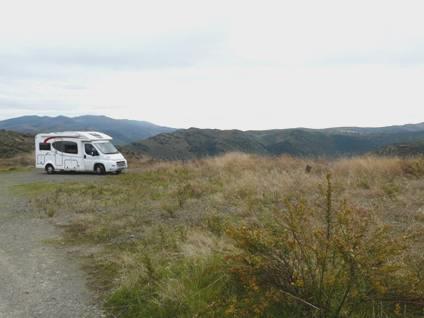
Our overnighter near the museum at Vila Nova de Foz Coa
We drove back into Vila Nova de Foz Coa, aware that today is a public holiday for All Soul’s Day. We tried first unsuccessfully for an internet connection.
We walked around the old town with its neatly cobbled and paved streets. There were lots of people about, and yes, the shops were open. We bought a rustic loaf and a bun from a cheery lady. We noticed the flowers shops with their brightly coloured, gaudy bunches of artificial flowers to go on the graves. As we passed the cemetery later, it was full of people doing just that.
The town would not appear to get many tourists, judging by the number of stares we got! Elderly ladies in black hobbled about. We looked into the sombre church with its nicely painted but dark ceiling. The front of the church was under wraps. The town was a mixture of restored and crumbling buildings.

Restored and not! Vila Nova de Foz Coa
There were great views out to the surrounding hills. We stopped to have coffee at picnic tables just out of the town. It had felt quite chilly, but was now pleasantly warm. We enjoyed the view of the hills, and once again the dogs were barking!
Our road now wound on through the hills south of the Douro. Olives and vines predominated, and we looked out to villages of whitewashed, red roofed houses. We stopped to have lunch by a spring, and filled two bottles with water.
The countryside now became almost all vines. The neat rows of them in the fields made wonderful patterns – a bit like a ‘take a line for a walk’ drawing, with each shape patterned differently. We were in the Alto Douro, the High Douro.
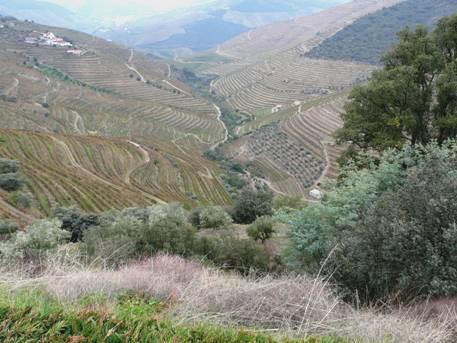
Some of the vines of the Douro
The road led down now beside the Douro near Pinhao, along the southern side. There were glorious reflections – it would have been even lovelier on a sunny day. All the big port manufacturers had their name emblazoned Hollywood style in the steep vineyards.

We visited Sandemans in 1996 in Porto
It became busier as we neared Peso de Requa, and began to drizzle. We pulled in opposite Peso de Ruego, and found that we had an internet connection at last. We had been working on our website, and wanted to send it. There was an Aire in Peso de Requa, so we thought it a good idea to head for that for the night. We found our way across the Douro (taking the wrong road first), and located the Aire, in a busy carpark beside the river. Unfortunately, we didn’t appear to have an internet connection here, or electricity from the boxes set up for that!
We walked out – down to the river first, where a large river cruiser was docked, ready to take passengers on a trip along the Douro. Our road bridge and the rail bridge were dwarfed by the massive motorway bridge. We then walked into a pleasant bit of old town, finding a tourist information – where again the lady spoke French, but a little English. We asked about a laundrette (always a problem when we’re away on a long trip). She told us that there was one, but with no street names, it was too difficult to locate it, so we returned in the greyness to the van. As it got dark, Adrian found that the internet did work (but slowly and sporadically)! We organised the website ready to send, but had to wait until tomorrow to do so.
We were at a much lower elevation, and noticed that it was much warmer in the evening.
Saturday 2nd November We leave the Douro and celebrate 350 nights 92 miles
The night was much warmer too! There was some noise from cars in the morning, but it had been a useful place to stay.
We walked across to the nearby covered market and enjoyed looking around it. We bought some peaches, chestnuts, cabbage and bread rolls. The Tourist Information was open as we left. We asked the lady again about the laundrette. With her directions, we drove there, but no sign of a laundrette. We did pass ‘Lavabo automatica’ – but that was a car wash!
We now had a long hunt for a good internet connection in order to send our website and email. We ended up across the bridge where we had first stopped yesterday!
It was 11.30 when we finally left Peso de Requa and continued along the southern bank of the Douro.
We enjoyed seeing the vines above the river, in glorious autumn colours, when the sun was shining. We wound on high up above the river, looking out to the numerous villages of red and white houses high up in the hills. There was no flat land – we were amused at a football stadium set in a massive concrete structure high above the river, clinging to the side of the hill.
Our going was very slow. We stopped for lunch sitting on a stone wall as the picnic tables were out of the sun. That is, until the rain came! It made a glorious rainbow above the river, and we moved under a tree!

Note the rainbow (before the rain)!
Sadly, that was the last of the sun, as the weather now deteriorated, and by the time we left the Douro at Castelo de Paiva, it looked very dismal!
We drove southwards through never ending forests of eucalypts, which seemed rather out of place to us. The rain became heavy, and visibility was poor as we made our way towards the coast. There was never anywhere to pull off to get our bearings. There were no Aires in this area, and it all seemed very busy after the hills.
At Ovar we started down the long sand spit on the seaward side of a long lagoon. We took a road off through forest, and found that it just ended at a remote sandy beach at Torrao do Lameiro – no car park or anything.
Fortunately there was a place to pull off just before the beach – our luck was in! It was 5 o’clock, and would soon be dark. We soon set about celebrating our 350th night in the Ixi. We opened the bubbly, and later some Vinho Verde and reminisced about our trip to Portugal in 1996.

350 nights in the Ixi!
Sunday 3rd November Joys and frustrations 62 miles
It was a fine, mild morning. Lots of fisherman had come down, and when we walked down onto the wide, white sandy beach, they were dotted along the shore. This was our first time on a beach this trip. The tide had come up very high last night. We walked back to the van past an atmospheric old boat.
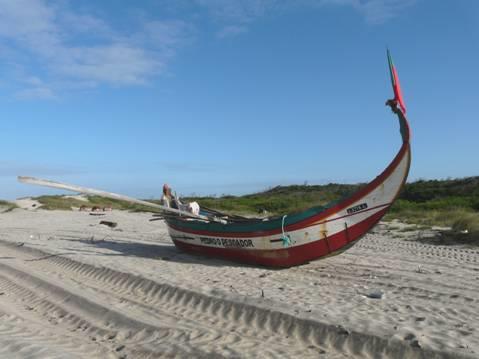
Atmospheric ‘up-ended’ boat
We discovered that our bag of rubbish, which we’d left outside on the step last night as we’d eaten fish, had been taken by an animal and left under our van!
We drove back through the forest, where people were out collecting something – maybe truffles, as they had bags and digging tools with them.
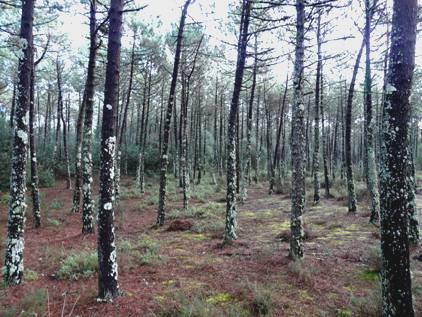
Through the lovely forest
As we neared the lagoon side of the sand spit, we saw that the Sunday cyclists were out in force. Hundreds of them rode noisily by, in groups of various sizes, shouting out to each other. There was a cycle track but many were on the road as well.
We stopped near Torreira on the lagoon side in the warm sunshine. Lots of people were in the shallow water collecting something – possibly clams. A woman and girl in front of us were kneeling in the water in their track suits for ages, digging out something. It was an idyllic situation, with the little ‘turned up ended’ boats making one think of a Venice painting with the pale blue sky and water and black silhouetted boats.

Silhouettes at Torreira
A cormorant sunned its wings on top of a post, an egret strutted along the shore, a fisherman cast his net from a boat, a baby toddled along with her dad.
As we drove on, cars were parked beside the water, and the Sunday fishermen were out!

Portuguese fishermen
We came to a nature reserve, where I’d wanted to have a walk. We stopped to have our coffee sitting on the beach opposite before setting off on our walk. The tourist information wasn’t open on a Sunday, and there were no maps available. There were coloured markers, which we followed, but we had no idea where we were going, or how long the trails might be! It was pleasant walking through the trees in the warm temperature. There was birdsong, and birds flew high above, but we couldn’t see any close up. A diagram showed that they’d be similar birds to ours – tits, woodpeckers, wagtails. There was some interesting fungi and lichen. We could hear the waves, but never saw the beach. We saw no people at all.
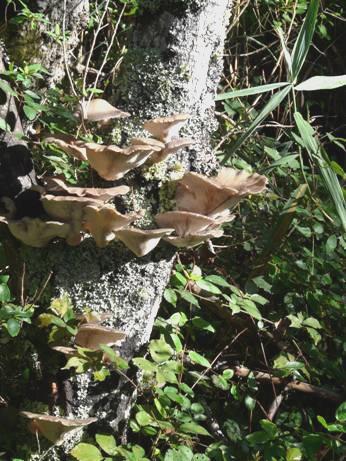
Fungi in the nature reserve
Back at the van, we drove on into Sao Jacinto, where we thought that we’d have something to eat. There were lots of bars, but we found a place which served food. We sat outside, opposite the lagoon – we were the only takers. Our waitress spoke English reasonably well, but the menu was interestingly translated. We ordered ‘rise with sea fruits’. When this came, it was a huge casserole of sea food and rice – quite delicious, but far more than we could eat! Adrian went back to the van and got a container to use as a ‘doggy bag’! As we had read, extras such as bread and olives are charged for in Portugal, whether ordered or not. Anyway, it was all very good, even if Adrian’s beer fell (or was blown) over!
There was a ferry from here to Aveiro, where we were heading, but Adrian didn’t fancy the Ixi’s chances on it, so we decided to drive back to a bridge over the lagoon. We drove over to the ocean side at Torreira before leaving the peninsula. We came to a massive beach of fine white sand, devoid of any people. We walked right across to where the rough waves were crashing and swishing onto the shore. It was a very pastel scene in blue, white and grey. Two little ‘upturned’ boats added to the atmosphere. The ‘town’ behind was quite smart and the road had been ‘poshed up’. The topes consisted of huge kerb stones which slowed the traffic down to zero.
Now we headed for Aveiro as we hoped to use its ‘services’. In fact, nothing was successful! We had note of an Aire where we could dump, but not stay, and Adrian had noted 2 laundrettes to try. It was 30 miles around the lagoon in the busy Sunday afternoon traffic. We had to forfeit looking at any of the villages on the way.
Following the sat nav, we managed to locate the so-called laundrettes (lavaderos), and in fact inadvertently a third, but all were cleaners of some sort, and closed anyway! Then the Aire had now been closed too, so no dumping! I’d hoped to get a glimpse of part of the town, which had canals and the little ‘upturned’ boats, but no chance of that! It all got a bit much for Adrian as we headed to Gafanha do Encarnacao on the coast, where we could overnight (but not dump). This was a smart holiday area, with a variety of different houses, but a place where we could stay right by the sand dunes. As we arrived at 5.30, a wedding couple were having their photos taken in the dusk!

A surprise wedding couple
We found enough energy to walk across to the beach and view the waves.
Tonight was a night for cheese and biscuits, followed by fruit salad.
Monday 4th November A wet one! 65 miles (accurately estimated by R)
The morning was windy and grey, but worse was to follow! We had reached crisis time with the loo, as the red light was showing. We needed to find somewhere to empty it imminently! We still braced ourselves for a quick ‘blow’ on the beach before leaving this spot, where several cats had lingered around the van.
We soon stopped at a pleasant little supermarket where we bought warm rolls and a hot pain au chocolat (which we enjoyed later) and some sangria for bonfire night tomorrow! The attractive houses here had a mixture of tropical plants including cacti and plumbago.
We now set off on a cross country route to the nearest ‘Aire’ with dumping facilities. We passed a massive area of picnic tables in the forest, but no noticeable parking.
We drove through the town of Vagos, which was modern in the centre, with EEC paving, but had a humbler outer part where older women in overalls took us back to our childhood! A gentleman on an invalid scooter trundled along amidst the fast traffic.
It began to rain as we drove inland through forests of mostly eucalypts to the town of Sangalhos – our saviour for today! At the Aire, we were able to dump, and also to get water. Hooray!
Now 10 o’clock we continued through the fertile, green countryside, looking more like England with large cabbages growing well!
We drove through the spa town of Luso, with its huge buildings, and came to Bussaco (Bucaco) National Forest. We had to pay 7 Euros to drive into here, and on a fine day it would have been wonderful! The trees were absolutely enormous. We were given a leaflet telling of a disastrous storm in January of this year, which had caused tremendous damage. We were to see evidence of this as we walked around. Trees had come down onto some of the ancient buildings, and others were still uprooted. The map we were given was miniscule, so we had no idea what the trails might be like. One went through a long valley of tree ferns. We walked around by the massive OTT Palace building – now a plush hotel. The outside was crenulated and fancy. There were neat box hedged gardens looking like a French chateau. We walked through a bit of the forest in the damp! We’d got a taster, but certainly didn’t enjoy it to the full.


Bucaco National Forest and palace
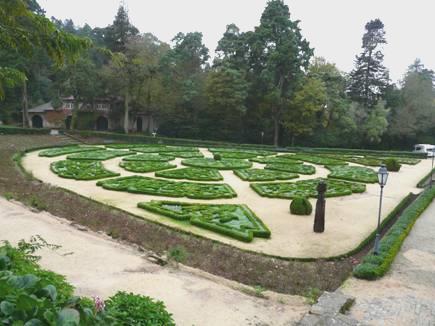
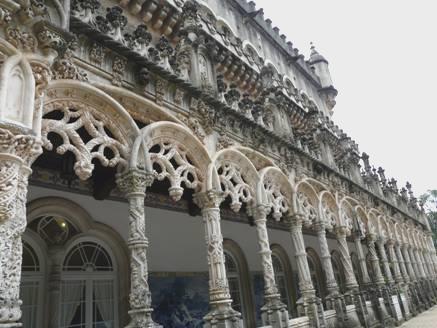
We drove out of the park, and stopped to have lunch by a ‘viewpoint’ at a memorial to the Battle of Bucaco, when the Anglo/Portuguese army had beaten Napoleon. The trouble was, there was no view, as the clouds had come down, and we could hardly see the monument even!
The onward journey down through forest would have been really pleasant on a nice day. We came out of the hills, but the weather was no better. We reached Coimbra, and after a couple of tours, located the Aire where we could stay. It was situated in a riverside park, opposite the large, steep town. It would have been lovely in nice weather, but it was still decidedly damp! We had a cup of tea, hoping that the weather would improve.
Armed with our umbrellas, we set off on foot. First we crossed the River Mondego on a footbridge which had sides made of translucent pink, blue, yellow and green. The bridge had a large kink in the middle – we thought that perhaps they started from either end and didn’t meet up!
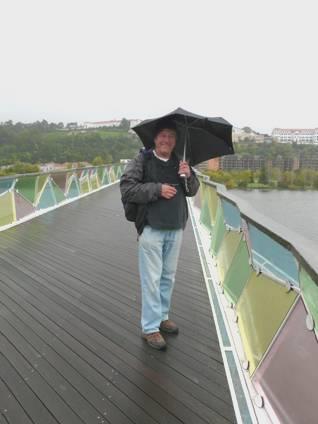
Adrian on the footbridge, Coimbra
We walked through the riverside park on the other side, calling in at the tourist information for a map (20 cents). The thing was, it was too wet to keep out, so didn’t help much!
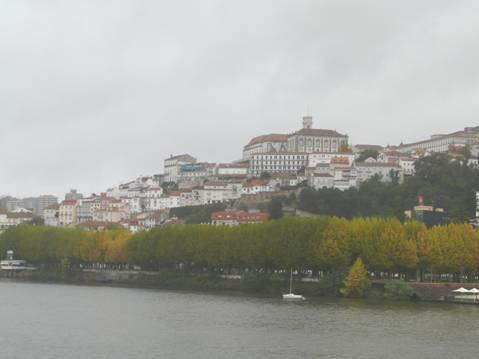
Coimbra
The town is very large and very steep. When we spied a little bus, we got on, and it took us along and up the main cobbled street, avoiding the pedestrians! We didn’t know if we were supposed to pay, or whether it was a bus for ‘oldies’ and infirm! We alighted by Santa Cruz church (dating from 1131) and looked inside. After that, we walked up the narrow, steep, cobbled streets, but with the rain and the tall buildings, it was difficult to get our bearings. We did come across the old cathedral, with its elaborately carved pillars around the door. We looked inside – it also dates from the 1100s. I’d have liked to walk back to the river through the botanic gardens, but as everything was rather difficult, we just followed our noses, and found ourselves back by the entrance to the town.
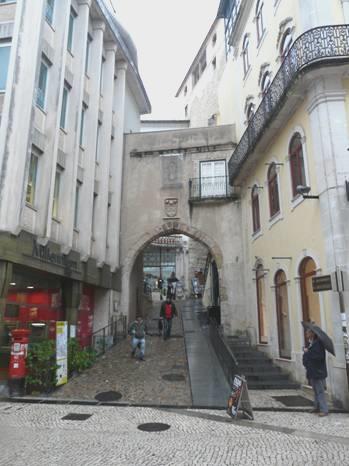

Gateway into Coimbra and the walk back
Now it was the long, wet walk back along beside the river and over the bridge. Here we smiled as we passed a bare-chested, barefooted jogger wearing just track suit trousers and a baseball cap! Down in the river, canoeists were playing with a football! One capsized and came back up to continue! We were just glad to get back to the van and sort out our wet things!
Tuesday 5th November Romans and forested coast 47 miles
We were disappointed to wake to a grey morning which soon turned to rain. We’d had no wifi here, as the book suggested, and nowhere to dump water. It was a lovely place to be able to overnight, just a shame about the weather!
We followed Adrian’s satnav to a nearby Lidl store, following a hairy route of narrow, steep streets this side of the river. It was a large Lidl store, with an identical layout to those in England. It served us well, and even better when we found that we had an internet connection in the car park. We had coffee while reading several new messages, and being able to reply to them.
We had a few places nearby which we’d like to visit, but a walk through a nature reserve didn’t seem appropriate in the rain! We settled on heading for a Roman site some miles south at Conimbriga, stopping to get diesel and propane on the way.
It was an excellent visit. As ‘oldies’ we only had to pay 2 euros each – the genial young chap joked that we were 42 and 43, the years on our driving licences!
The site of the excavations was extensive, and we had the place almost completely to ourselves. And – the rain more or less held off!
We loved the variety of floor mosaics and marvelled at the expertise of the Romans. During the 4th century AD, after the Romans had left, there were many invaders and the locals decided to build a big wall through the site to keep them out, dismantling many of the Roman buildings to use as material – early building vandals! There was a museum with artefacts found at the site – all in for the price!
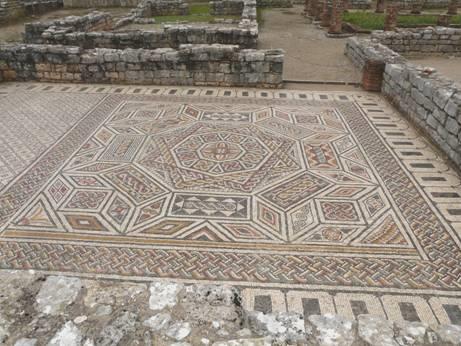
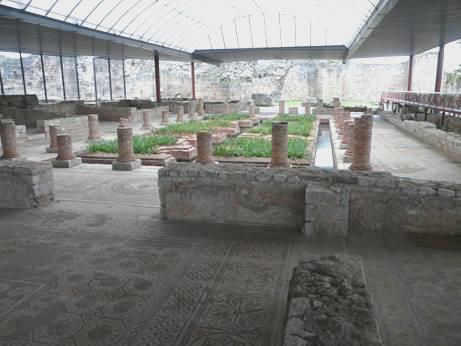
Conimbriga Roman ruins
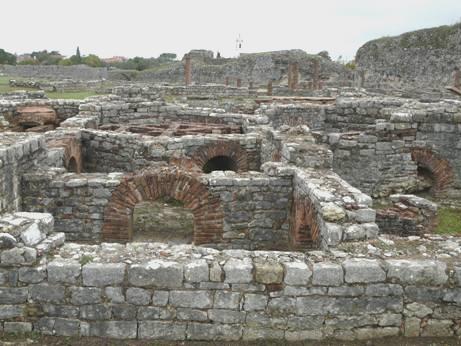
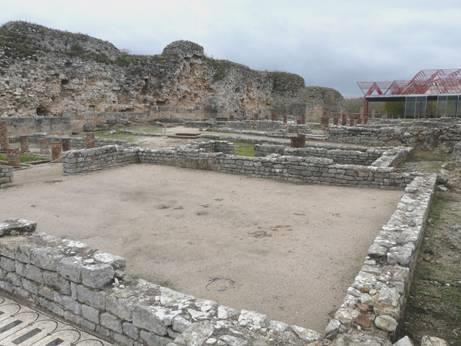
Now 2.45, we took a cross country route towards the sea, to a part we hadn’t visited in 1996. The last 5 miles or so to Pedrogao were on a very rough road through pine forest. The surface had mostly disintegrated and there were holes and bumps galore! This was obviously the back way! We reached the wild beach with crashing waves at 4 o’clock. Sand had blown across the road, making it seem like Exmouth! We had a quick walk out to the beach, where the sea looked turbulent and grey, with a glimmer of yellow on the horizon. The town was shut up and deserted. In summer we could imagine it being packed!

The wild coast at Pedrogao
Just out of the town, we came into the forest again – the forest had originally been planted 700 years ago. We soon found a nice spot just off the road, with a stony base so that we wouldn’t get stuck in the sand.

Our coastal forest overnighter
Adrian photographed the pine trees with their atmospheric resin-collecting pots, as we remember seeing many years ago in France.
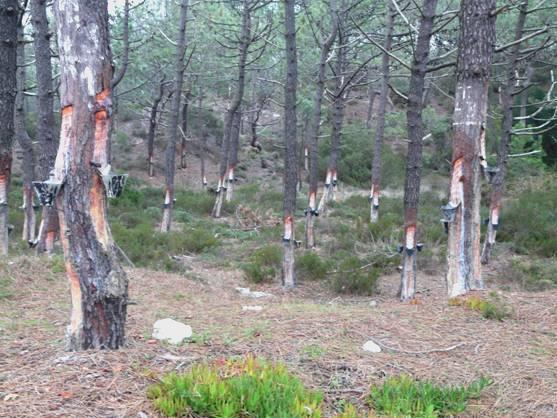
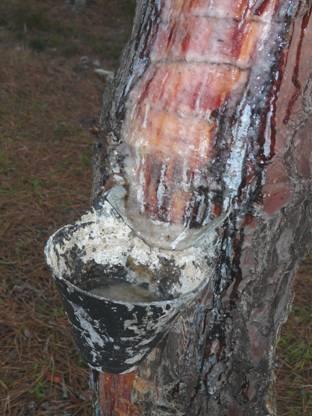
Collecting pine resin
We set off immediately, thinking that we’d walk through the dunes to the beach. We could hear the waves crashing, and joked that it might be further than we thought.
We walked through the forested dunes until we came to a sandy track running parallel to the shore. We walked along it for a way in both directions, but never found a turn off! We could only assume that it was a track for ATVs or motorbikes.
We had no bonfire or fireworks for 5th November, but made our own celebrations with Sangria instead of mulled wine, and eating soup, followed by roasted chestnuts, sweet potato and squash.
We discovered that we must have driven past or very near ‘de Klomp’ campsite, where we had stayed in 1996 and talked of often.
Wednesday 6th November Bonuses as we head inland 43 miles
The morning was fine, but grey. We had enjoyed our isolated woodland setting.
We left at 9.30 and drove back the short way into Pedrogao hoping to get the internet connection we had got yesterday. This was more difficult than we thought, and entailed driving along some very bumpy cobbled streets. We parked back by the beach, where the seats set in the white wall were painted in pastel yellows and greens. The waves looked very grey as we walked on the wooden walkway and steps to cross the wide sandy beach to the edge of the sea. Much of the beach had been washed away, with the steps left a bit high and dry.
We left here at 10.15 and headed for the next village down the coast – Preia de Vieiro. We had to follow a diversion (yet again) to get there. This seaside village seemed more alive and upmarket than Pedrogao. The sea ‘wall’ was of vertical blue railings and there were some picture-postcard striped huts.
We drove south through some of the vast area of forested dunes. We passed one or two lone walkers on the cycle/footpath, and wondered where they could be walking to. We turned off to drive through the forest on an extremely bumpy track, which ended above the sea. We were surprised to see quite a few cars parked here, until we realised that it was a fishing spot! We had our coffee sitting on an inland facing seat set into the wooden walkway way above the sea.
We drove on to Sao Pedro de Muel, the last of the little resorts on this bit of coast, and even smarter than the others. It was set high above the sea. We made a very hairy descent to a lower level on a steep, narrow road with a balcony jutting out at a right angle bend! We were then able to park by the wide sandy beach and I had a paddle. Around the rocks, the sand was very plodgy. Sea mist was lurking.

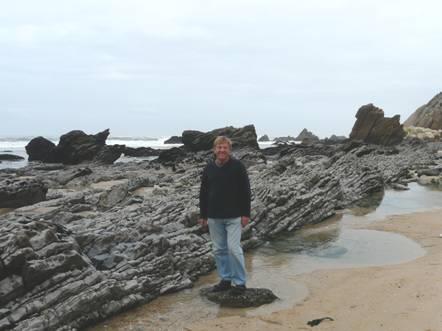
Farewell to the beach in Portugal, Sao Pedro de Muel
Now we were leaving the beach to head inland towards Fatima.
We stopped in Marinha Grande and shopped in a pleasant little Dia supermarket. We bought some bread, and two large potatoes. The cashier asked me several times about them, then gave up. I realised too late, that those at the front were priced differently from those at the back!
We were pleased to get the loaf, as it was lunchtime, but then something even better. Adrian noticed a ‘Lavaderio self service’ – a laundrette!! The first we’ve seen this trip. We’d given up hope of finding one, and I’d even washed a couple of things by hand this morning. Everything was written in Portuguese of course, and there was a machine to pay, but with the aid of our dictionary we mastered it! We gathered up our enormous load of washing, and were able to fit it all into the ‘large’ machine (there were 3 sizes).
Magic! Fun came with drying it – we wondered why it was still damp. Back to the dictionary – we had put it on ‘cold’!
The laundrette was completely empty, until a woman came in with all her household furnishings – had we been a bit later, we’d have struggled to get a machine!
We had eaten our lunch during this time – not the prettiest spot, but the most welcome! To crown it all, we found that we had an internet connection too! We tried phoning Emma, and she had just turned on her computer, so we chatted on skype, so a real bonus (using our phone is very expensive in Portugal).
Adrian had joked earlier that he thought that we might be in Fatima by midmorning. Now we wondered if we’d get there today at all!
We headed that way, passing the town of Lieira with its dramatic castle set high on a hill, but we had to give that a miss.
We arrived at Fatima at 4 o’clock, being astonished that the Aire where we could stay is as close to the basilica as anyone could park!

The view of Fatima from our van
Having pulled in, we set off to visit. We had come here in 1996, and have always joked about the fact that my ankle, which I’d hurt badly the night before while stepping out of the way of a car, had miraculously healed when Adrian left me as he went to park the van.
Fatima has been a place of pilgrimage since 3 young children had apparently seen a vision in 1917. Two of the children had died in the flu epidemic after WW1. The third died in Coimbra in 2006.
We had forgotten how enormous the site is. We walked first into the basilica, where mass was taking place (one of many times a day). The singing was really beautiful and moving. There were quite a few people in the church, and wandering around the vast area outside. We lit two candles in the designated place.

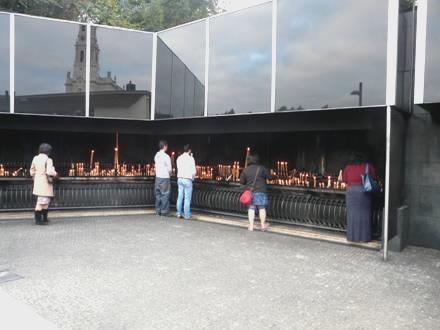
The pilgrimage place of Fatima
We walked on to see a large piece of the Berlin wall set under glass.
We returned to the van to the sound of the VERY loud bells which toll every quarter hour, and other times too! Our book says they stop at 10 00 pm, we hope that’s right!
Thursday 7th November To Evora 129 miles
Luckily it was right! As we got ready for bed, we could hear the 10 o’clock mass, and then sure enough at 7 o’clock, the bells started up again!
It was a cloudy morning as we did the ‘chores’, the water filling being particularly difficult as it had a different nozzle.
We didn’t leave until almost 10 o’clock. We passed hundreds of bland hotels and numerous restaurants, but no bakers! Apparently the population of Fatima is 8,000, but there are guest beds for another 10,000! We couldn’t imagine so many people wanting to come here.
We set off to drive cross country to Evora. At times the sky cleared and it became warm. We crossed the River Tego on a long red iron bridge. I had wanted to go to Santarem. Adrian diverted reluctantly, but it was an abortive visit. The town is set high above the River Tego, with a castle Porto do Sol, set in the former Moorish citadel. We ascended to the town, but it was large, busy and had no signs. We could find nowhere to stop, and with the narrow streets, overhanging balconies and new one way system (not on Adrian’s satnav), he was exhausted! We missed seeing any of the buildings, just the nice blue and white azulejos on the covered market. We descended and returned to our route, viaAlmeirim, where we stopped to have lunch in the large carpark by the bull ring.
We continued on our way to Evora, passing many ‘speed control’ traffic lights – if you go faster than the speed limit, a red light stops you. Seems a good idea to me. Also, as elsewhere, the daturas were dripping with their yellow or white trumpet flowers.
We reached Evora at about 4 o’clock, but decided it too late to go into the town tonight. We parked on a rough bit of carpark beside two other motorhomes, but they very soon left. After the mostly grey day, the sun gave a splendid display just before setting.

A burst of late sun at Evora
Friday 8th November Evora in the rain and Monsaras in the sun 37 miles
We should have walked into Evora last night! The grey morning turned to heavy drizzle (Adrian’s pet hate) and then rain just as we left on foot at 9.15! We had moved the van to a busier part of the car park nearer the city walls for safety.
We made our way up the steep street to the main square, which luckily was where the tourist information was sited. We got a map of the town (for 50 cents), but had the same trouble as in Coimbra – it was too wet to keep looking at it. We were amused that they were lifting out seating for the restaurants in the centre of the square!
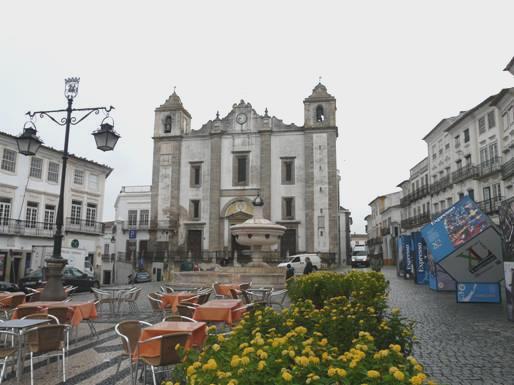
The main square in Evora
Walking around was difficult yet again, with the narrow cobbled streets, and far too much traffic scraping through. Some streets weren’t wide enough for a car, let alone a pedestrian with an umbrella too!
We looked inside large, sombre Sao Antao church where the lady was waiting to take 50 cents if you photographed (we didn’t). We tried walking under the arcades beside the road, out of the rain, but they seemed full of noisy young people!
We made our way to the end of the Roman viaduct and then on to the splendid site of a Roman temple, looking quite out of place! It became windy now too, which added to our difficulties with umbrellas and camera!
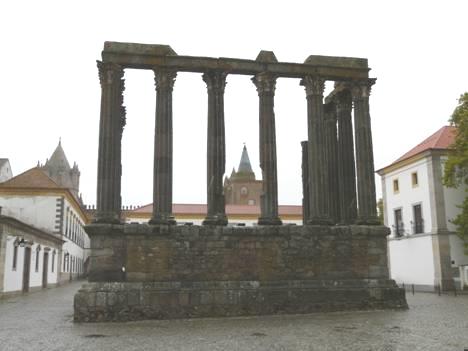
The splendid Roman temple
We actually walked a great deal of the city. We walked around the outside of the vast, barrack-like cathedral, tucked in amongst the streets, and admired the many arches in the town walls.

One of the arches at Evora
We had thought that we would be able to walk through the botanic gardens on our way back to the van, as I’d missed so many others, usually because of the weather. Thwarted again – the gates were closed!
After 2 hours of wandering around in the wet, we were glad to get back and have a cup of tea/coffee – and then, to add insult to injury, the sun came out!
We drove around the outside of the walls to the other end of the aqueduct, which looked impressive and great with the blue sky! What a difference a bit of sunshine makes!

The Roman aqueduct at Evora
The city walls were amazingly well restored and preserved. The town of Evora is a world heritage site, but we felt that although it had such potential, it seemed unloved and lacked pride. The assistant who served us in the little cafe/ bakers summed up our feelings of the place – she had complete disinterest, so unlike what we have usually found.
We set off now on our route back towards Spain through pleasant country with one or two nicely kept villages.
We drove through the workaday town of Requengos, which looked well kept, with a nice, interesting looking church in blue and white. We passed a man on a loaded donkey – not something we’ve seen in recent times.
We were making our way to Monsaraz, a hilltop walled town which looked worth visiting. Following a sign for motorhomes, we realised that this was a place where we could stay – we had unwittingly missed it in our book. We drove right up a cobbled street and found that the parking was just beneath the ancient walls. Several motorhomes were here already. The views down were amazing. Rivers here have been flooded to form the barragem de Alqueva – a whole area of natural looking lakes.
We set off to walk around the walled town. It was absolutely delightful with white painted houses lining the little cobbled streets – and NO CARS! Apparently there are very few permanent residents here now. We did pass an elderly gent hobbling with his stick but everywhere was so quiet.

Top spot Monsaraz
The views all around were staggering – wherever you looked there was a view. There were a few eating places, and one or two nice little tourist shops – we bought a small painted bowl in one. To top it all, there were ruins of a castle which you could wander around. Part of it had been made into a bullring.
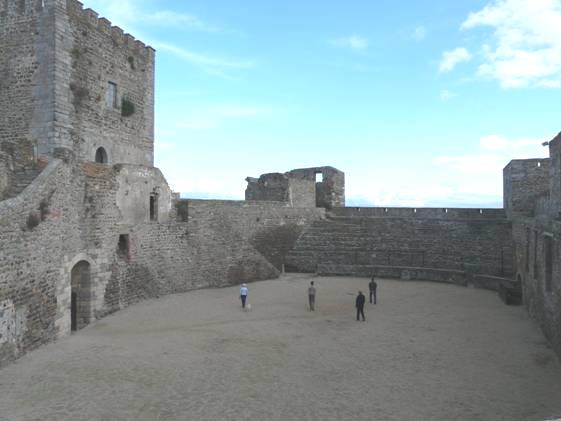
The castle/bullring at Monsaraz
We voted Monsaraz a top spot, and didn’t need much persuading to stay the night here, although there were no facilities.
We came back to enjoy a cup of tea sitting on a stone wall, with the countryside set out beneath us, and joined by a little black cat.
The sky lit up gloriously as the sun went down.
It was a lovely place to be for our last night in Portugal.
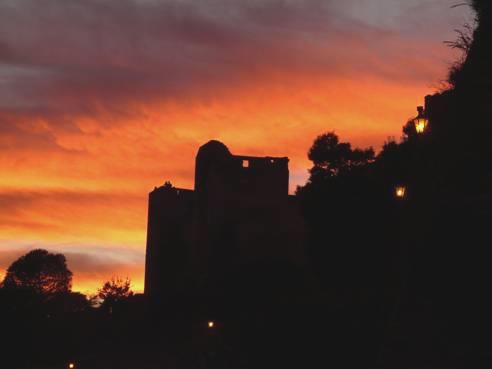
Glorious evening sky at Monsaraz, Portugal
Saturday 9th November Farewell Portugal, hello again Spain! 143 miles
The only downer to staying here was that the church bells rang (twice) every hour throughout the night!
The sun rose magnificently into a clear blue sky.
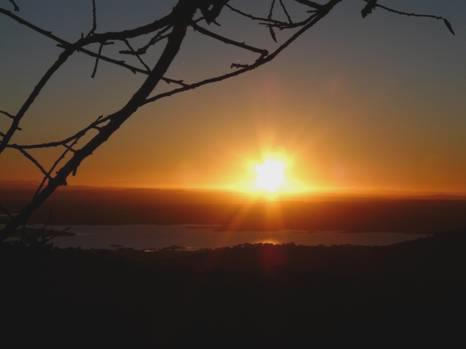
And then sunrise!
We left at 8.40 - we wanted an early start, as we would be losing an hour when arriving back in Spain.
We enjoyed the wonderful sight of all the lakes made by the dams as we descended the hill. We headed for the town of Mourao, a few miles away (not to be confused with nearby Mouro)! Mourao has a walled castle on top of a hill, and the roundabout at the entrance to the town had a large model of it. We drove on a bit further to the town ofLuz, as this had an aire where we could dump and get water. We could have stayed here too, but settled last night on the lovely view at Monsaraz.
The village of Luz has been completely rebuilt after the former one was flooded by the damming of the river. It looked really attractive with its low white houses, some edged with yellow or blue or other colours. Laden orange trees lined the roads.
Having used the facilities, we drove back to Mourao, and up to the castle. We parked right by the entrance, and walked inside. Unlike other places, there were just ruins inside the walls. It was absolutely great wandering around in our isolation. The castle had been built in the 1300s. It felt really spooky, especially when birds soared up from the ruins – like a Hitchcock film! It felt quite cool and windy in the shade.
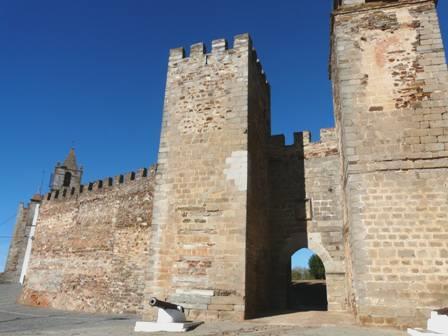
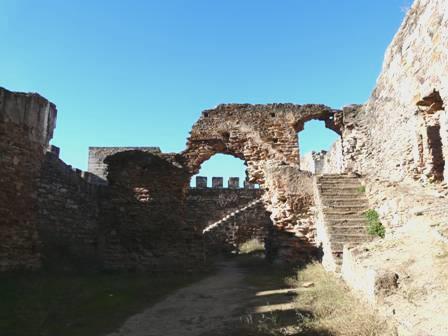
The castle at Mourao
We returned to the van and drove back past the village of Mourao, with its white chimneys making us think of Guadix in Spain.
We now took a pleasant rural route to the border with Spain. Often the road was tree-lined – sometimes with fir trees, and other times with deciduous trees in their bright autumn colours.
Just before the Spanish border, we could see the large pink and white town of Barrancos spread out on the hillside, sparkling in the sun. Some of the houses were edged with yellow, and many had iron balconies. We inadvertently drove into the town. It was a mistake! Being Saturday morning, it was busy with cars and pedestrians, and became a nightmare for Adrian as he tried to get out again!
After extricating ourselves, we almost immediately came into Spain. We stopped for lunch just before crossing the Modrigo River. It looked really atmospheric, with the golden autumn trees, a derelict house and lots of sheep.
We continued through the attractive Sierra de Aracina. The actual red and white town of Aracina was in a nice situation with a castle set on a hill, and a huge barrack-like stone cathedral.
We continued to the outskirts of Seville. We wanted to visit, but didn’t know where to stay tonight. Our route took us past the Roman ruins of Italica, so we were hoping that this might offer a suitable place to overnight after visiting it. We turned off the main road, and realised that we had come into habitation, after all the miles of countryside. We actually drove right past the entrance, which was hiding beside a garage!
We found our way back, and went into the site. The cashier said ‘English or French?’ What a pleasant surprise to find that for European citizens, it was free! (It wasn’t expensive anyway).
The site was enormous, and very neatly and attractively laid out, with trees and plants.
It was the birthplace of both Hadrian (Adriano) and Trajan. We followed a ‘suggested route’, which was written in both Spanish and English, but we gave up on some of the outlying parts. Again there were some nice mosaic floors.
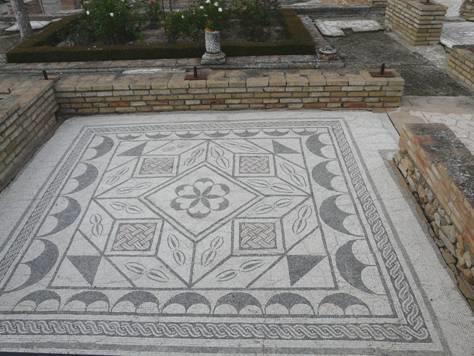

Two of the marvellous mosaics at Italica
We ended by the amphitheatre, returning to the van at 6 o’clock Spanish time.

The amphitheatre
We debated whether to stay on a side road here (it was near a football stadium), or return to a picnic area a few miles back. We opted for the latter, arriving just as the sun set beautifully.
Sunday 10th November Splendid Seville and charming Carmona 82 miles
It was a lovely morning. We enjoyed a fried breakfast in our nice situation – between road and motorway, but very quiet. I had had cramp in the night – not a good thing when we were setting out to walk a lot, but luckily it settled down.
We left at 9.30 and drove into Seville. Motorcyclists were out in their hundreds, cyclists in their dozens, plus a few joggers. We noticed ‘Camino de Compostela’ signs. The orange sellers were already out.
We drove along beside the Guadalquivir River, past the futuristic bridge looking like a rocket taking off, and a huge, unfinished ultramodern building.
Seville looked very smart, with its tree lined avenues, with lots of palm trees. We were disconcerted to see that all the roadside parking was already full. We were wondering where we might park, but eventually were directed in by a ‘guide’ (like we remember from our 1996 visit) to a spot which was fairly central. We paid him a few euros to ‘look after’ the van, and thought it a good bargain!
We set off on foot, but the thing was, we didn’t know where we were! We had Lonely Planet, with a map, but it didn’t help as it didn’t reach this far! We wandered for ages, enjoying the splendid buildings, but not knowing where we were, which was particularly hard for Adrian!
After walking through some pleasant gardens we came to a fantastic area, which we later discovered was the Plaza de Espana. Adrian immediately remembered being here in 1996. On that occasion, it had rained nonstop. We had loved Seville despite the rain, and vowed to return. Today we were seeing it in perfect weather - the temperature was just right.
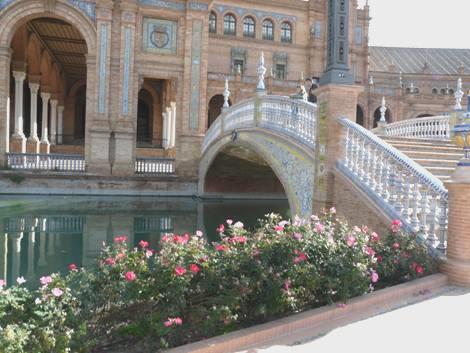
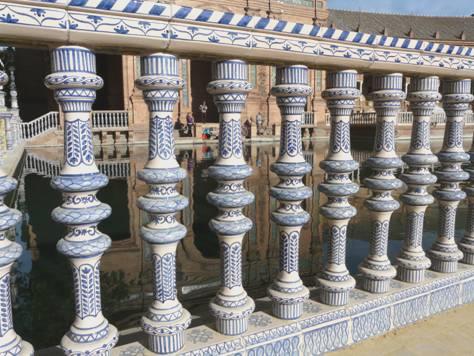
Breathtaking Plaza de Espana, Seville
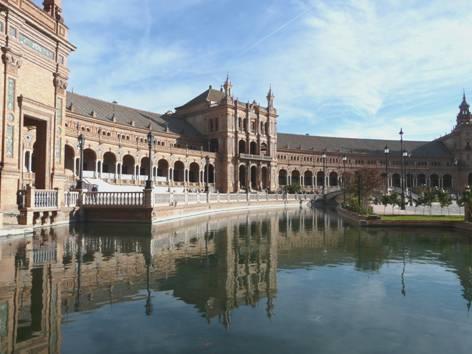
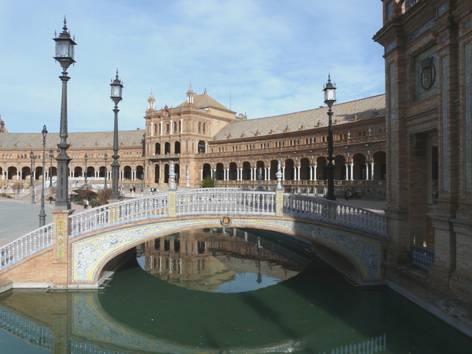
The buildings were sumptuous and really ornate, with blue, white and yellow tiles set into the bricks. There was a fountain, and a small pond, with boats ready for later. Horses and carriages waited for the willing tourists. An Andean musician was playing – later we heard other street musicians – a cellist and a flamenco player in particular. There were already a few people about – there would be far more later.
We watched a little wagtail as we wandered on. I picked up a map from a place advertising boat trips, and we tried to work out where we were! Soon afterwards we picked up another map from a so-called tourist information, which was really just trying to sell their tourist bus trip.
Now we came to the immense cathedral – only open in the afternoon today. Around it were dozens of stalls selling little figures – we realised that it was the Christmas market, which had just opened for the season. We were able to peep inside the cathedral, where mass was taking place. We had done this in 1996. We saw what we thought was Christopher Columbus’ grave, but then realised that it wasn’t, but later did see Christopher Columbus’ column.
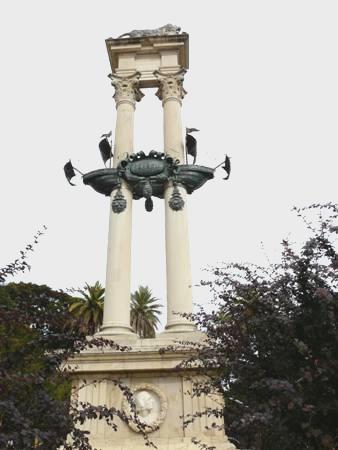
Christopher Columbus’ column, Seville
Right by the cathedral we stopped to have a coffee/tea at a pleasant little cafe (mostly so that I could use the loo), sitting underneath orange trees. It wasn’t expensive, and was a super place to collect ourselves. It was now 12.00, so 11.00 in England. We thought of Remembrance Sunday, amongst all this hustle and bustle.
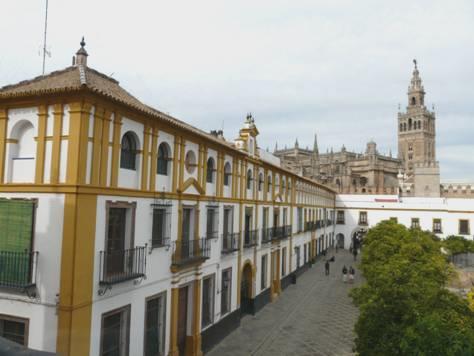
Outside the Alcazar looking to the Cathedral, Seville
We had thought of visiting the Alcazar, but the queue looked enormous. We went into part of it where there was an exhibition of paintings. In the surrounding little streets, stalls were selling fans and flamenco dresses. We walked through the Alcazar gardens with its massive trees and plumbago plants, and then wandered on to the Maria Luisa gardens, where lots of people were enjoying themselves. There were sumptuous plants, including lovely daturas. Some young people were rollerblading, and others were on bicycles – some were on ‘bicycles made for 4 or 6’ – it brought back memories!
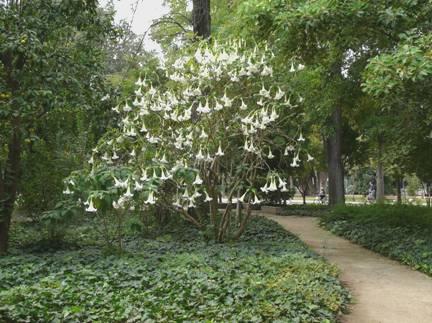

Maria Luisa gardens, Seville
We arrived back at the Ixi at 1.30, and enjoyed lunch after our superb visit.
At 2.45 we set off for Cordoba, but on the way turned off to the town of Carmona. We had read that there were Roman sites here. After some time, we came to the Roman amphitheatre (not open, but we could look through the fence). Opposite was a site of a Roman necropolis. We walked in, hoping for a quick look around. The man came out of the ticket office, asked where we were from, then just handed us a leaflet in English. We then had a delightful wander around a huge site with dozens of ‘holes in the ground’, which were ancient burial places. Signs were in both Spanish and English.

Roman tombs at Carmona
Having left the tombs, we drove through the white town, where the only life was the people sitting in the outdoor restaurants, until we came to the Puerto de Sevilla – a superb Roman gate into the old town. We were able to park opposite – then we set off on foot to discover another delight, wandering the narrow streets of this white town. A few older people were walking around, otherwise there was no-one.
On suddenly hearing much noise, we walked up some steps to find a square surrounded by arches, where kids were playing, and adults sitting at outside cafes.
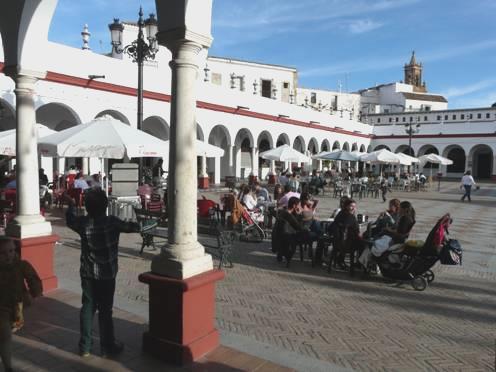
A happy square in Carmona
Wandering on, we came across huge brick churches set amongst the white houses. There were some tall marble pillars outside one.
After a long time we came to Puerto de Cordoba, which we could look through to see the plain set out far below.
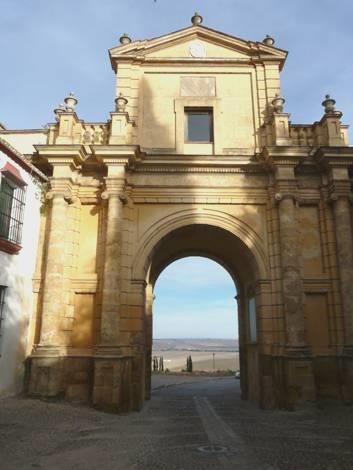
Cordoba gate, Carmona
On our way back, we came across another square, where groups of young girls had gathered.
It was gone 5.00 when we got back to the Ixi, so now we took a ‘white’ road towards Cordoba, looking for somewhere to stop for the night.
We were driving through the fertile area near the River Guadalquiver, where the fertile red/brown soil was just right for the orange groves. It didn’t look hopeful, especially as a railway line ran either side of the road. There was not an iota of space to pull off. Occasionally there were fields of cotton, reminding us of USA. In desperation, we turned off onto a smaller road, but this was no better.
It was 6.30 when I spied the first bit of rough land we had seen. We pulled in, and settled down with a drink, watching the lovely sky before darkness fell. We were surprised at the number of cars which passed in this rural situation. Then we were amused at some blue and green lights, with a heart lit up above them – a remote restaurant – making us think even more of America!
Monday 11th November Cordoba 106 miles
We left early, at 8 o’clock, just as it was getting light. There was a clear blue sky, but the low sun shining in made driving very difficult. We headed for Cordoba following the satnav, taking roads not on our map at first. We passed the picture-book castle on top of a hill at Almodovar. We had come out of orange growing country, and much of the land was ploughed, some with huge watering systems. There were silos, and a rail link.
We passed olive groves, one lot with nets beneath the trees. We didn’t see anywhere where we could have overnighted, so were glad that we stopped when we did last night.
Cordoba is also on the Guadalquivir River, and the first thing we saw was a modern double arched bridge across it. Parking though was the worst ever on this busy Monday morning. We really thought that we’d have to give up. In the end, at 9.40, we found a ‘blue badge’ spot, and with parking one wheel on the pavement, fitted into it.
We wanted to get to the Mesquita – the huge moslem temple which houses the cathedral. Lonely Planet said that it was free before 10.00am. We tried to rush along the narrow cobbled streets, but didn’t really know where we were going, and of course there were no signs!
When just before 10.00 we came to a ticket office in a likely looking ancient building we thought that we’d found it. However, we had to pay 4.80 euros each (oldies rate half price). We started to walk around, and to match the towers with the plan in Lonely Planet. It was then that we joked ‘perhaps it’s not the same place’, and no, it wasn’t – we were in the Alcazar de los Reyes Cristianos and not the Mesquita!
It was still a good visit, being the town’s ancient castle.

The Alcazar in Cordoba
There were very few visitors, and we could wander unhindered through the narrow corridors and up steep steps. There were extensive, well tended gardens with a whole series of long ponds edged with orange marigolds. Our ticket would have allowed us back to watch a ‘son et lumiere’ performance at night, which would have been nice.


The ponds and gardens in the Alcazar with Ferdinand and Isabel talking to Christopher Columbus
There was a statue of Ferdinand and Isabel talking to Christopher Columbus, who they had met here in 1486, set among the tall topiaried fir trees.
We walked on to the Mesquita and into the orangery. It was already busy here – and would have cost 8 euros each to go in - it seems you had to be there by 9.30am to go in for free, so we would never had made it! We decided that we wouldn’t go in – Adrian was a bit ‘churched out’.
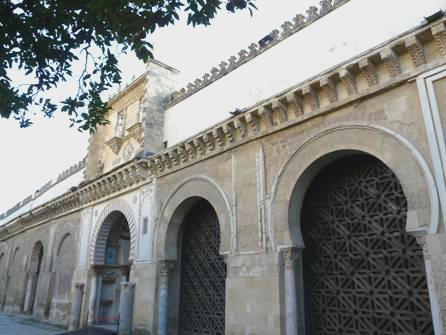
The Mesquita from the orangery
We wandered on through the narrow streets, supposing that we were in the renowned Jewish quarter, but it didn’t seem any different to us! It was while we were wandering about, that the phone beeped with a message we couldn’t understand, and after logging in on our other phone, we realised that it was from Matt, saying that he and Marion are expecting a baby!
We stopped to have our first icecream of this trip before walking back beside the river, starting at the superb Roman Bridge and passing the Roman waterwheel.

The Roman bridge and waterwheel, Cordoba
It was lunchtime when we reached the van. We still had no bread, and had run out of drinking water, and had the vain hope of finding a little store. The drive around was even more horrendous, with fast roads and one-way systems. We ended up at a northern suburb, where the town was still spreading, and pulled in at the roadside for Adrian to recover, and then to have lunch – with Tuc biscuits for the second day running! Just before we left, we heard what seemed to be a French style bread van, but he didn’t stop long enough for us to see!
We set off on a fast road south, through hilly olive country. We turned off to drive through Lucena, hoping to find a supermarket. We hadn’t expected to find a massive Carrefour, and the worst one we have ever been into. You had to walk the entire length of the shop to get in. We weren’t impressed by the quality of the fresh goods. There were very few customers, but when we got to the only checkout we could see open, and waited our turn, we were told it was for ‘up to 10 items’ only. We made our way to the far end, where another till was open. Adrian’s cucumber had no price on it (although they were all one price). The cashier put it on one side, and we never did get it! Adrian was asked for his passport, and failing that diving licence to support his credit card! I suppose they didn’t ask for proof of his age for the wine!
We continued south, arriving at an Aire at Villavueva de Algaidas at 6 o’clock, just before the sun went down.
Adrian rang Fred and arranged to meet up tomorrow.
We read through the recent part of the diary, as the (nicely) noisy sounds came from the adjacent floodlit football ground.
Tuesday 12th November To friends in Nerja 84 miles
The sun rose above the hills as we had breakfast. We left at 9 o’clock, having done the ‘emptying and filling’.
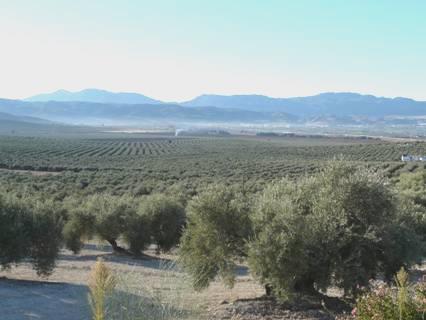
Anyone for an olive?
We drove through the sea of olive trees to Antequera, which like so many towns, was larger than we’d thought. We had the usual trouble of driving through narrow roads, not knowing where we were. We were about to give up, when we came across a parking area below the town. Two coachloads of nursery children had just emptied out. They were all dressed in navy and grey uniforms, and were in a line, each holding on to the skirt or jumper of the child in front.
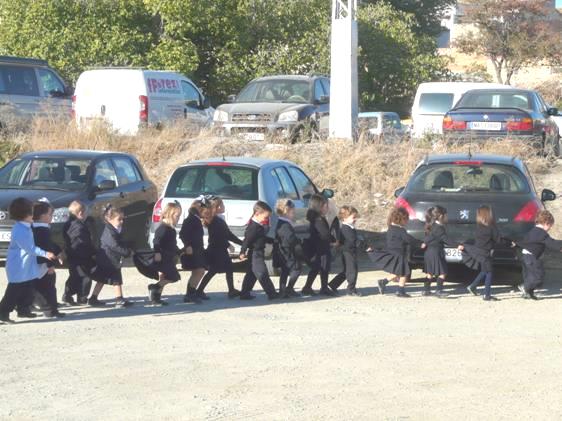
Follow my leader!
When we returned, they were going back to the coaches, but now they were running.
We made our way back to the Tourist Information which we had driven past. A nice young girl gave us a map, with a suggested tourist route marked on it. This pretty town is known to have 28 churches (plus a castle!) We started by looking inside St Sebastian, which was opposite. It was large and ornate, and very quiet – this town is not on the coach tour route.
Antequera is very hilly, so we started ascending on the smartly cobbled patterned streets. When we reached the castle, there was an amazing panorama of the sparkling white town spread out beneath us, making me think of Athens. Beside us were partly excavated Roman baths.


Antequera
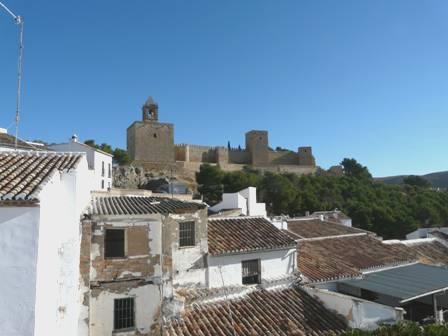
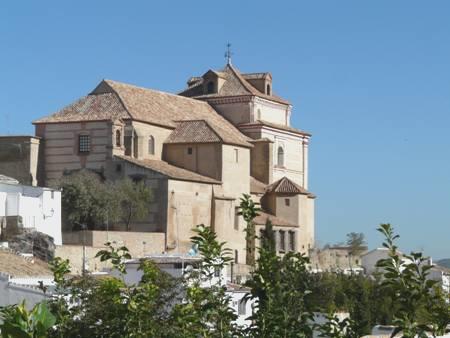
The houses were all very well kept up. Through open doorways we could see lovely colourful tiles. We seemed to take a wrong turn, but just enjoyed roaming the quiet little lanes away from the main part of the town. I peeped inside Carmen church, which was really colourfully decorated.
It was nearly midday when we returned to the van. We had planned to drive on to see some dolmens, and then El Torcal, a hilly area which has ‘hoodoo’ type rocks. Adrian worked out a route which went right around the outside of the town for several miles to avoid driving through the narrow centre again. Having driven most of the way round it, we suddenly found ourselves back in it, with the route pointing down a narrow road. In avoiding his, we were once more right back in the centre – Adrian’s worst nightmare with the ever narrowing streets, one-way system, overhanging balconies and astonished looking pedestrians.
Somehow we extricated ourselves, but Adrian was a bit stressed. There was nowhere to pull in and peruse the way we wanted to go. We gave up on the sites, and managed to find our way south on a fast road, turning off into the hills towards Nerja, where we are to meet up with Fred and Lib. Even now, we couldn’t find anywhere to pull off the road to recuperate and to have lunch. Finally, amongst the arid olive region, we spied a rough bit of ground where we could stop.
Adrian rang Fred, and we drove to Moro, where we had arranged to meet them. They had located a parking area where they thought that we could stay the night. It seemed ideal, beside the wall of an ancient mill, high above the sea.
Fred & Lib then drove us back to their house in Nerja, where we had a happy time chatting – at first sitting up on their ‘roof’ with a cup of tea.

We meet up with Fred and Lib at Nerja
We emailed Ruby to wish her a happy birthday for tomorrow.
We all walked out through the narrow streets of Nerja, to Balcon De Europa, which we had had visited with Jill and Tony in 1996
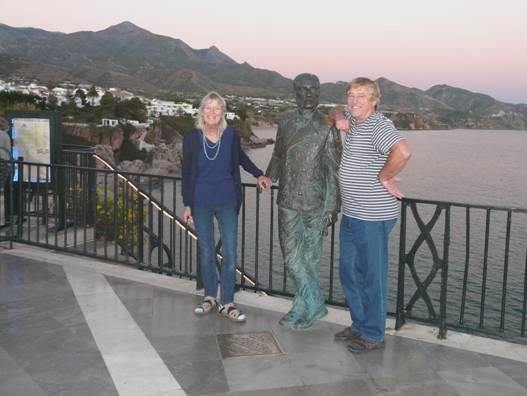
At Balcon de Europa, Nerja
Later we ate fish at a nearby restaurant, coming back to their house for more chat until Fred & Lib drove us back to our ‘pitch’. It had been great meeting up.
Wednesday 13th November We can make it rain! 72 miles
It was a lovely morning. We spent some time catching up from yesterday and assessing the next stage of our trip. Having completed the ‘cultural’ bit, we were now hoping for a few relaxing days near the coast, before we meet up with Tom & Mar again. We walked out briefly, but could see that it was a long way down to the sea.
It was really warm by the time we left at 10 o’clock. We set off along the coast eastwards, stopping at a high up viewpoint looking back to Nerja, which has expanded dramatically since our last visit.

Looking back to Nerja
We stopped at another pull-off where there were masses of parking places, but we couldn’t see what for. As we drove off, we could see a walkway through a reserve area to a viewpoint. We were now entering the ‘plastic greenhouse’ area, and also far more development than we remember
A tiny bit of the plastic greenhouse ‘sea’
We drove down to la Herrandura, which was vast and still growing. There were a lot of cars parked along by the beach, but we managed to find a space, and sat on our new Danish ‘beach seats’ to have our tea/coffee on the beach of coarse grey sand strewn with pebbles. We were just annoyed by the flies. Even getting out of this town was more than difficult, with the narrow roads, badly parked cars and altered one-way systems.
At Almunecar, where again there was much development, we had a quick walk to the sea and I had a short paddle – and Adrian got a wet foot too!
We drove past Motril to Torrenueva. We parked by the end of the beach and ate our lunch sitting on seats and looking through palm trees to the sea. This seemed a less salubrious place, with not such upmarket flats behind. It was quite lively with chatter from the one restaurant. Further along someone was playing the guitar.
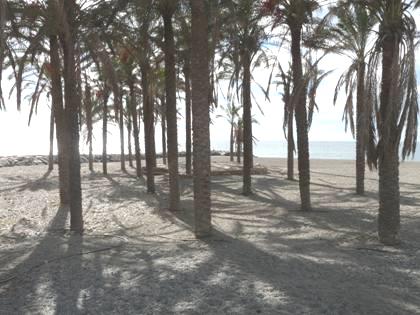
Torrenueva
We continued on an older bit of road. There was a ramshackled mess of nets and plastic which wasn’t pretty. Something to think of when we buy our Spanish tomatoes and cucumbers!
At El Pozuela the new road towered above on a very high bridge.
We came to Adra – quite a big coastal town, and it rained!!
We stayed on the old road and just after Balerma pulled onto a rough bit of beach. Plastic greenhouses were behind us, but the view out to sea was nice. We had a quick look at the sea – but not the barbecue which we had had near this spot in 1996!
We telephoned Ruby to say happy birthday. The sun emerged to give a lovely sky as it set, but then the rain returned.
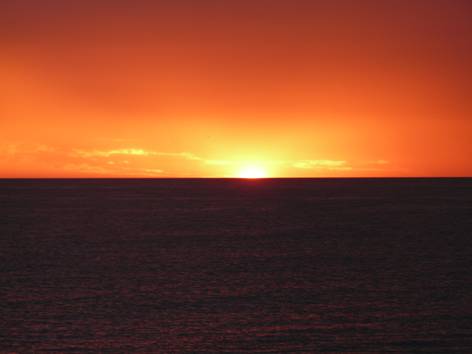
Thursday 14th November Peace at last! 106 miles
It was raining again in the morning but had stopped by the time we left at 9.50.
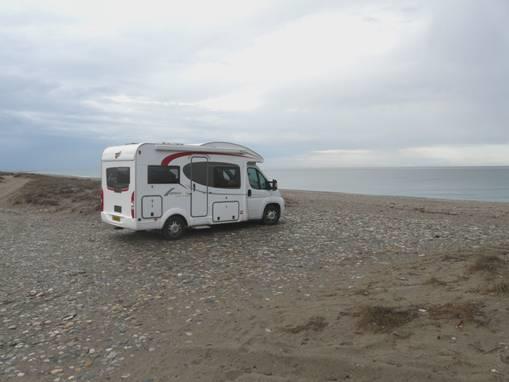
Nice place to overnight
We continued driving through this area which we had enjoyed in 1996, but now was a sea of plastic greenhouses or expanding development. Small areas that were free of these were thick with bits of disused plastic. All the workers we passed were black. After an hour, we stopped to have coffee at Roquetas. Afterwards we shopped in a Dia store which wasn’t brilliant. Another customer kept trying to tell us what we should buy, picking something up and saying ‘very good, Spanish’, then she would chat to us in Spanish!
We drove past Almeria on the autovia, it looked big and ugly in its arid setting. Later we discovered that it had hidden talents with a great 10th century alcazabar which we perhaps should have investigated.
We turned off towards Cabo de Gata, stopping by the sea at El Toyo to have lunch. We walked across the beach of coarse brown sand to the sea.
We drove on a bit towards Cabo de Gata, but decided not to continue as it was a long way, and we’d have had to come back this way. We had been there in 1996. At the point where we turned round, there was a large field of marrows, which made a welcome change from the plastic!
At last we came into the wild and desert-like Parque Natural Cabo de Gata/Nijar.
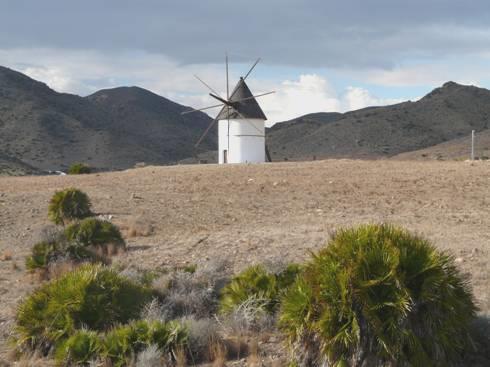
We made our way past an evocative windmill to San Jose, a white moorish-looking town like others round here. We saw a place for motorhomes to park, but not overnight. The town was really quiet as we drove around, but we couldn’t ever get to the sea. We continued to la Isleta, another silent village by the sea. Nearby we stopped at Mirador de la Armatista where we clambered over an uneven and rocky access to get a lovely view of this unspoilt bit of coast. A real treat! We saw a crested lark.
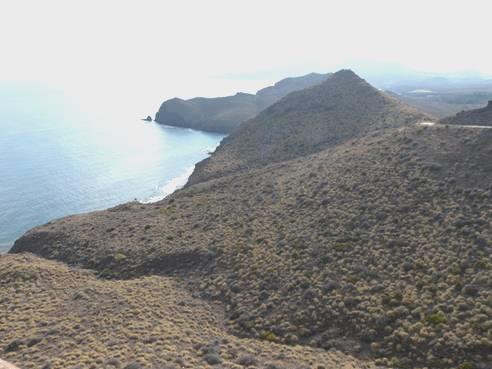
Spanish coast as it used to be
Our road now went through Rodalquilar, a white village, but with the desolate houses of the former gold mining town which it once was.
Then we came out of the park, and back to the sea of greenhouses. We tried to think of them as the actual sea, and then they wouldn’t look so bad!
We made our way now to a motorhome service station near Nijar. This was at the motorway truck stop, and our book recommended not overnighting there. It seemed ordinary enough, and Adrian was able to dump and get water, and then fill with diesel.
We needed somewhere to stay for the night, so drove back one section of the autovia before driving through Nijar and heading up into the hills, which we thought would be easier. This wasn’t so! We wound up into the arid hills, but it was 5.40 before we found anywhere suitable to stop. We had wonderful views right down to the coast with the last of the now clear blue sky.
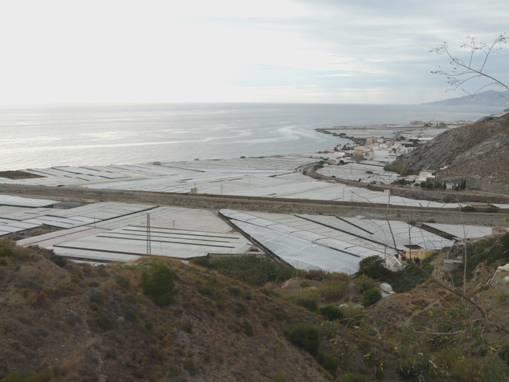
Portugal and back to Spain















